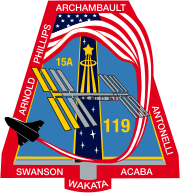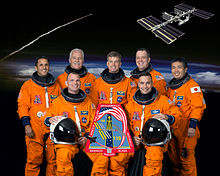STS-119

Backdropped by the Earth, Discovery's approach to the station was photographed by Expedition 18 crewmembers
|
|||||
| Mission type | ISS assembly | ||||
|---|---|---|---|---|---|
| Operator | NASA | ||||
| COSPAR ID | 2009-012A | ||||
| SATCAT № | 34541 | ||||
| Mission duration | 12 days, 19 hours, 29 minutes, 33 seconds | ||||
| Orbits completed | 202 | ||||
| Spacecraft properties | |||||
| Spacecraft | Space Shuttle Discovery | ||||
| Launch mass | 120,859 kilograms (266,448 lb) | ||||
| Landing mass | 91,166 kilograms (200,986 lb) | ||||
| Crew | |||||
| Crew size | 7 | ||||
| Members |
Lee J. Archambault Dominic A. "Tony" Antonelli Joseph M. Acaba Steven R. Swanson Richard R. Arnold John L. Phillips |
||||
| Launching | Koichi Wakata | ||||
| Landing | Sandra H. Magnus | ||||
| Start of mission | |||||
| Launch date | 15 March 2009, 23:43 UTC | ||||
| Launch site | Kennedy LC-39A | ||||
| End of mission | |||||
| Landing date | 28 March 2009, 19:13 UTC | ||||
| Landing site | Kennedy SLF Runway 15 | ||||
| Orbital parameters | |||||
| Reference system | Geocentric | ||||
| Regime | Low Earth | ||||
| Perigee | 402 kilometres (217 nmi) | ||||
| Apogee | 385 kilometres (208 nmi) | ||||
| Inclination | 51.6 degrees | ||||
| Period | 91.6 minutes | ||||
| Docking with ISS | |||||
| Docking port |
PMA-2 (Harmony forward) |
||||
| Docking date | 17 March 2009, 21:20 UTC | ||||
| Undocking date | 25 March 2009, 19:53 UTC | ||||
| Time docked | 7 days, 22 hours, 33 minutes | ||||
|
|
|||||


Front row (L–R) Antonelli, Archambault. Back row (L–R) Acaba, Phillips, Swanson, Arnold and Wakata.
STS-119 (ISS assembly flight 15A) was a space shuttle mission to the International Space Station (ISS) which was flown by Space Shuttle Discovery during March 2009. It delivered and assembled the fourth starboard Integrated Truss Segment (S6), and the fourth set of solar arrays and batteries to the station. The launch took place on 15 March 2009, at 19:43 EDT.Discovery successfully landed on 28 March 2009, at 15:13 pm EDT.
This mission was originally scheduled to bring the Expedition 9 crew to the ISS. This crew would have consisted of:
STS-119 delivered the S6 solar arrays to the space station, completing the construction of the Integrated Truss Structure. STS-119 also carried several experiments, including the Shuttle Ionospheric Modification with Pulsed Local EXhaust (SIMPLEX), Shuttle Exhaust Ion Turbulence Experiments (SEITE), and Maui Analysis of Upper Atmospheric Injections (MAUI). STS-119 was also used for the "Boundary Layer Transition Detailed Test Objective" experiment. One tile of the thermal protection system was raised 0.25 inches (6.4 mm) above the others so that, at about Mach 15 during reentry, a boundary layer transition would be initiated. This experiment was repeated during STS-128 with the tile raised to 0.35 inches (8.9 mm), tripping at Mach 18 to produce more heat.
...
Wikipedia
